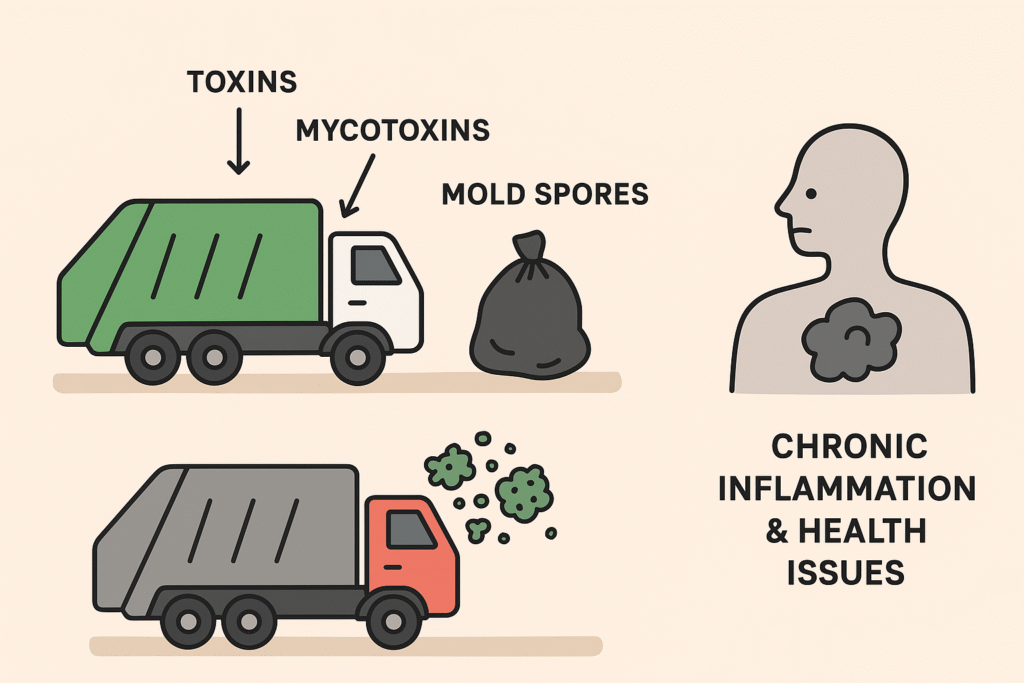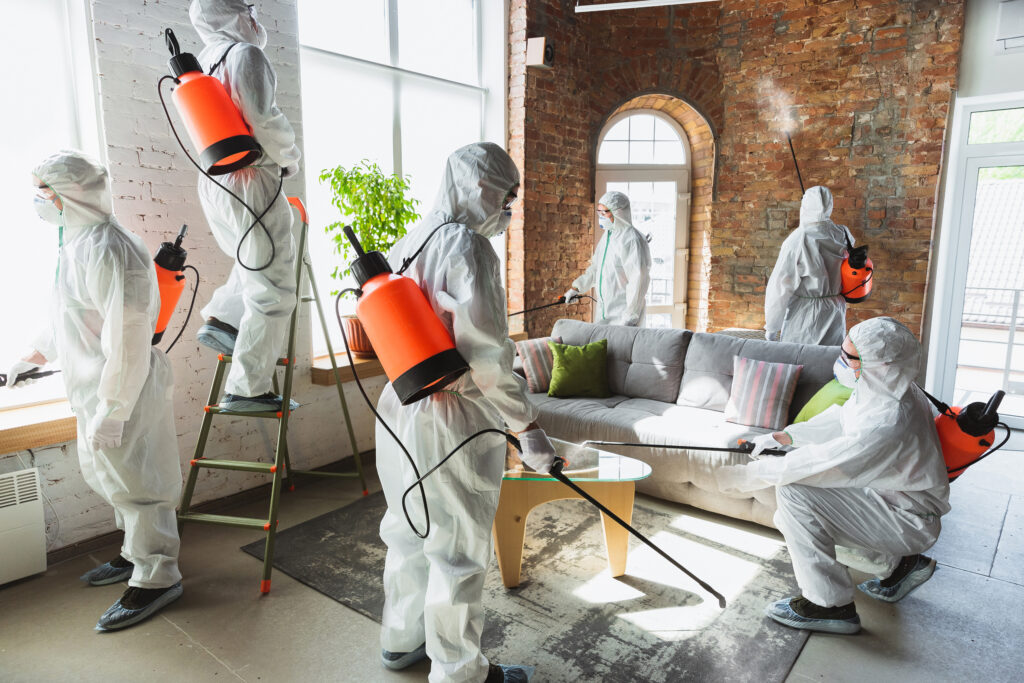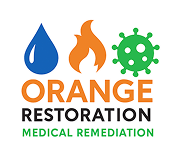Water is flooding your home, and every second counts, you need someone you can trust to handle the damage repairs.
…But if you have CIRS, the Stakes are Even higher.
You need to minimize the risk of cross-contamination, prevent mold growth, and ensure the air you breathe afterward is free of VOCs and toxins from building materials.
Why it’s NOT “just water damage” for CIRS Patients
Water damage means life for the VOCs and mostly mold contaminates that CIRS patients cannot manage once internalized. With CIRS patients, they cannot remove these toxins from their bodies alone. So, CIRS patients are debilitated by tiny microscopic systematic clutter that these patients cannot detox from.

Visual Explanation: Why CIRS Patients Cannot Handle Mold Spores:
- Most people have a garbage truck that picks up trash (toxins, mycotoxins, and mold spore particles) and hauls it away with less problem or symptoms.
- On the other hand, some people (with these HLA gene variations) have garbage trucks that don’t recognize certain types of trash. Instead of removing it, they just let the trash pile up, causing all sorts of problems. Imagine mold spores building up in your immune system, this doesn’t sound good, does it?
- When exposed to mold or other biotoxins, these people’s bodies don’t clean up properly, leading to chronic inflammation and health issues, this is CIRS.
Even Small Leaks = Big Health Risks. -The Medically Sound Remediators
The Hidden Danger
Most water damage restoration companies follow standard protocols focused on visible cleanup and structural drying. While this is necessary, it’s not enough for individuals with mold sensitivities or conditions like CIRS (Chronic Inflammatory Response Syndrome).
The real danger lies in the microscopic contaminants that remain after traditional restoration, ultrafine particles, mold fragments, mycotoxins, and VOCs.
Suggested Read: Micro or “Nano”-Particulates 101
These particles are invisible to the naked eye but can circulate through your HVAC system and settle on every surface, continuing to impact your health long after the water damage appears “fixed.
Often, we are called in for secondary mold, where we are needed to cleanup someone’s poorly done mold project which has turned into a mold jungle, all because the mold has been hidden away by new drywall.
Common Mistakes
Standard remediation mistakes often lead to secondary mold growth and/or ongoing health issues. The most common issues include:
- Poor containment – Without proper barriers and negative air pressure, contaminants spread into clean areas during repairs.
- Cross-contamination – Bringing in outside crews or untrained subcontractors increases the risk of introducing new contaminants. Check to see if a remediator has all in house trades and if the whole team has been trained on CIRSx Containment protocols.
- Ignoring particle load – Most restoration companies never measure or reduce ultrafine particles, leaving the environment unsafe for medically sensitive individuals. Make sure they are doing CIRS Safe Remediation!
These mistakes are why many homeowners experience mold returning after water damage or notice health symptoms even after what they had thought to be a “successful” remediation.
What Makes Water Damage Repairs CIRS-Safe?
CIRS-safe water damage restoration goes beyond drying and basic cleanup. It involves advanced health-based protocols to ensure the environment is truly safe for recovery:
- Advanced Moisture Control + Verification: All hidden moisture sources must be located and fully dried using professional tools like thermal imaging and moisture meters to prevent hidden mold blooms.
- Small Particle Cleaning (SPC): SPC is a critical step for reducing ultrafine contaminants such as mold spores, fragments, and dust that standard cleaning leaves behind.
- HEPA-Based Cleaning Protocols: Every surface is HEPA vacuumed, wiped with non-toxic solutions, and cleared using air filtration devices designed for medical-grade cleaning.
- Third-Party Clearance Testing (PRV): Post-remediation verification ensures the environment meets strict safety standards before anyone returns, giving peace of mind to medically sensitive clients.
Why Choosing the Right Team Matters
When it comes to water damage restoration, the team you hire determines whether your home becomes a safe haven or a lingering health hazard. Choosing the wrong contractor can lead to recurring mold, worsening health conditions, and significantly higher repair costs down the road.
Unfortunately, many companies take a “rush job” approach, focusing on quick drying and cosmetic fixes without addressing microscopic contaminants or preventing cross-contamination. These shortcuts may save time upfront, but they leave behind invisible risks like mold fragments, mycotoxins, and ultrafine particles.

By contrast, a CIRS-safe, medically sound team follows strict containment, moisture control, and small particle cleaning protocols. This ensures not only structural restoration but also verified air quality and safety for medically sensitive individuals.
Action Steps for a Safe, Healthy Restoration
If you’re dealing with water damage and want to avoid the long-term health risks of mold and biotoxin exposure, especially if you or someone in your home has CIRS or other environmental sensitivities, every decision counts. A rushed or incomplete restoration can lead to recurring mold, secondary contamination, and serious health implications. Here’s how to protect your health, your home, and your investment:
- Work with certified experts: Only trust a remediation team trained in CIRSx Medically Important Remediation. This ensures they understand the unique needs of individuals with mold-related illness and follow advanced, health-based protocols.
- Ask the right questions:
- Confirm the team uses medically sound remediation techniques and includes Small Particle Cleaning (SPC) to remove ultrafine particles, mycotoxins, and fragments traditional cleaning and even traditional remediation services leave behind.
- Ask if they can rebuild and fully restore your home.
- Can they handle all trades needed for the job?
- Are all professionals on the team trained in CIRSx Medically Important Remediation or trained in the protocols for containment and cross-contamination prevention.
- Insist on comprehensive protocols: Proper containment, HEPA filtration, and moisture control are non-negotiable for preventing cross-contamination and secondary mold growth.
- Get verification, not just promises: Require third-party Post-Remediation Verification (PRV) testing to confirm your home meets strict clearance standards for particle load and indoor air quality.
- Plan for long-term safety: Ask if the team provides guidance on future prevention, including humidity control, maintenance tips, and safe material handling for any necessary rebuild.
Pro Tip: You deserve to feel confident that professional remediation work was done. If they do not pass PRV testing after a job, they will need to do more work. If they do not offer a PRV testing, they probably aren’t used to being held accountable for their work. This is a huge red flag in mold remediation.
